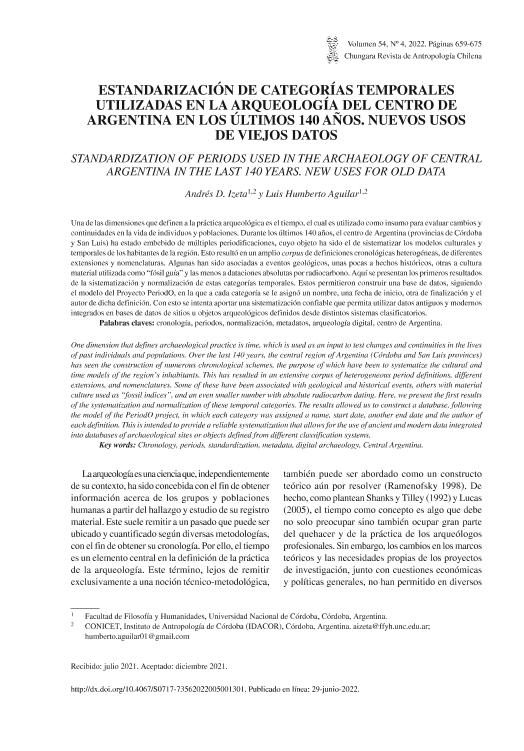Mostrar el registro sencillo del ítem
dc.contributor.author
Izeta, Andres Dario

dc.contributor.author
Aguilar, Luis Humberto

dc.date.available
2023-11-02T11:24:54Z
dc.date.issued
2022-06
dc.identifier.citation
Izeta, Andres Dario; Aguilar, Luis Humberto; Estandarización de categorías temporales utilizadas en la arqueología del centro de Argentina en los últimos 140 años: Nuevos usos de viejos datos; Universidad de Tarapacá. Facultad de Ciencias Sociales y Jurídicas. Departamento de Antropología; Chungará; 54; 4; 6-2022; 659-675
dc.identifier.issn
0717-7356
dc.identifier.uri
http://hdl.handle.net/11336/216825
dc.description.abstract
Una de las dimensiones que definen a la práctica arqueológica es el tiempo, el cual es utilizado como insumo para evaluar cambios y continuidades en la vida de individuos y poblaciones. Durante los últimos 140 años, el centro de Argentina (provincias de Córdoba y San Luis) ha estado embebido de múltiples periodificaciones, cuyo objeto ha sido el de sistematizar los modelos culturales y temporales de los habitantes de la región. Esto resultó en un amplio corpus de definiciones cronológicas heterogéneas, de diferentes extensiones y nomenclaturas. Algunas han sido asociadas a eventos geológicos, unas pocas a hechos históricos, otras a cultura material utilizada como “fósil guía” y las menos a dataciones absolutas por radiocarbono. Aquí se presentan los primeros resultados de la sistematización y normalización de estas categorías temporales. Estos permitieron construir una base de datos, siguiendo el modelo del Proyecto PeriodO, en la que a cada categoría se le asignó un nombre, una fecha de inicio, otra de finalización y el autor de dicha definición. Con esto se intenta aportar una sistematización confiable que permita utilizar datos antiguos y modernos integrados en bases de datos de sitios u objetos arqueológicos definidos desde distintos sistemas clasificatorios.
dc.description.abstract
One dimension that defines archaeological practice is time, which is used as an input to test changes and continuities in the lives of past individuals and populations. Over the last 140 years, the central region of Argentina (Córdoba and San Luis provinces) has seen the construction of numerous chronological schemes, the purpose of which have been to systematize the cultural and time models of the region’s inhabitants. This has resulted in an extensive corpus of heterogeneous period definitions, different extensions, and nomenclatures. Some of these have been associated with geological and historical events, others with material culture used as “fossil indices”, and an even smaller number with absolute radiocarbon dating. Here, we present the first results of the systematization and normalization of these temporal categories. The results allowed us to construct a database, following the model of the PeriodO project, in which each category was assigned a name, start date, another end date and the author of each definition. This is intended to provide a reliable systematization that allows for the use of ancient and modern data integrated into databases of archaeological sites or objects defined from different classification systems.
dc.format
application/pdf
dc.language.iso
spa
dc.publisher
Universidad de Tarapacá. Facultad de Ciencias Sociales y Jurídicas. Departamento de Antropología
dc.rights
info:eu-repo/semantics/openAccess
dc.rights.uri
https://creativecommons.org/licenses/by-nc/2.5/ar/
dc.subject
CRONOLOGÍA
dc.subject
PERIODOS
dc.subject
NORMALIZACIÓN
dc.subject
METADATOS
dc.subject
ARQUEOLOGÍA DIGITAL
dc.subject
CENTRO DE ARGENTINA
dc.subject.classification
Arqueología

dc.subject.classification
Historia y Arqueología

dc.subject.classification
HUMANIDADES

dc.title
Estandarización de categorías temporales utilizadas en la arqueología del centro de Argentina en los últimos 140 años: Nuevos usos de viejos datos
dc.title
Standardization of periods used in the archaeology of central argentina in the last 140 years: new uses for old data
dc.type
info:eu-repo/semantics/article
dc.type
info:ar-repo/semantics/artículo
dc.type
info:eu-repo/semantics/publishedVersion
dc.date.updated
2023-11-01T11:15:35Z
dc.journal.volume
54
dc.journal.number
4
dc.journal.pagination
659-675
dc.journal.pais
Chile

dc.journal.ciudad
Arica
dc.description.fil
Fil: Izeta, Andres Dario. Consejo Nacional de Investigaciones Científicas y Técnicas. Centro Científico Tecnológico Conicet - Córdoba. Instituto de Antropología de Córdoba. Universidad Nacional de Córdoba. Facultad de Filosofía y Humanidades. Instituto de Antropología de Córdoba; Argentina
dc.description.fil
Fil: Aguilar, Luis Humberto. Consejo Nacional de Investigaciones Científicas y Técnicas. Centro Científico Tecnológico Conicet - Córdoba. Instituto de Antropología de Córdoba. Universidad Nacional de Córdoba. Facultad de Filosofía y Humanidades. Instituto de Antropología de Córdoba; Argentina
dc.journal.title
Chungará
dc.relation.alternativeid
info:eu-repo/semantics/altIdentifier/doi/http://dx.doi.org/10.4067/s0717-73562022005001301
Archivos asociados
